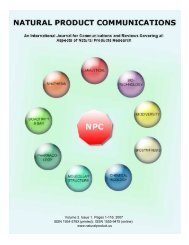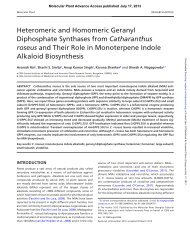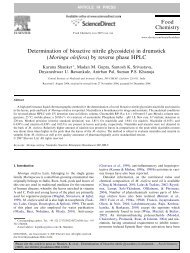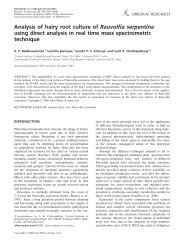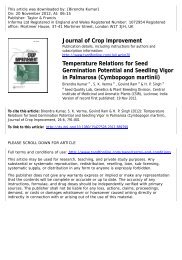Rose-scented geranium - CIMAP Staff - Central Institute of Medicinal ...
Rose-scented geranium - CIMAP Staff - Central Institute of Medicinal ...
Rose-scented geranium - CIMAP Staff - Central Institute of Medicinal ...
Create successful ePaper yourself
Turn your PDF publications into a flip-book with our unique Google optimized e-Paper software.
220 Plant Cell Tiss Organ Cult (2007) 90:215–223Fig. 2 Comparativeaccount <strong>of</strong> variousmorphological characters <strong>of</strong>transgenic and controlplants <strong>of</strong> Pelargoniumgraveolens cv. Hemanti8070605040302010Control Plants TransgenicPlants0Plant height (cm)No. <strong>of</strong> branchesNodes/branchLeaves/branchMorphologicalcharactesrRoots/plantRoot length (cm)One <strong>of</strong> the 11 transgenic plants, LZ-3, producedflowers in 3 months with two inflorescences, eachbearing four flowers could be seen during the entirecultivation period and the flower size was smallerwith reduced petals and abnormality in their shape(Fig. 1G and H). The small flower size in thetransgenic plant in comparison to control was alsoreported in tobacco (Tepfer 1984). A hundred percentpollen sterility could be recorded through acetocarminestaining technique. The cuttings were usedfor maintaining and further multiplication <strong>of</strong> transgenicplants for three successive years.All the 11 transgenic plants along with theircontrol were subjected to quantitative and qualitativeanalysis <strong>of</strong> their essential oils after 5 months <strong>of</strong>transfer to the pots. It was observed that all the plantsshowed stable behaviour in this duration. The oilcontents <strong>of</strong> all the transgenics were comparativelylower than the wild type (Table 4) in contrast to anearlier report (Pellegrineschi et al. 1994). Taking intoconsideration the number <strong>of</strong> leaves and branches, anoverall increase in the oil yield can be predicted fromthe transgenics since higher herb yield normally has astronger correlation with the oil yield per plant(Saxena et al. 2000). The analysis showed that theoils <strong>of</strong> nine transgenic plants (A6, 2TG, 5TG, 6TG,10TG, 12TG, 13TG, 15TG and 20TG) had compositionsimilar to that <strong>of</strong> the control Hemanti type(Table 4) which represents Chinese <strong>geranium</strong> oil inhaving higher amounts <strong>of</strong> citronellol and loweramounts <strong>of</strong> geraniol (Saxena et al. 2000). Theconcentrations <strong>of</strong> citronellol and geraniol as well astheir esters were found to be at par in thesetransgenics with those <strong>of</strong> the wild type oil. Amongthese nine transgenics, the oil <strong>of</strong> A6 was unique inhaving very low concentration <strong>of</strong> 10-epi-c-eudesmol(0.2%) which signifies better odour value (Teisseire1987). As compared to the oils <strong>of</strong> the other eighttransgenics and the control, the oil <strong>of</strong> 6TG was foundto contain lower concentration <strong>of</strong> isomenthone.Unaltered oil pr<strong>of</strong>iles <strong>of</strong> these transgenics mightrepresent the fact that the insertion sites <strong>of</strong> Ri TDNAin these plants do not interfere with the secondarymetabolites biosynthetic pathway as is mostly notedin majority <strong>of</strong> medicinal plants (Jung and Tepfer1987; Banerjee et al. 1998; Zehra et al. 1999).The RAPD analysis <strong>of</strong> these transgenics alsorevealed similarity at genetic level with that <strong>of</strong> thewild type in terms <strong>of</strong> most <strong>of</strong> the primers used.However, the primer OPT 1 revealed distinct differencesbetween the wild type and A6 in terms <strong>of</strong> thepolymorphic bands (Fig. 3) which might account forthe distinctiveness <strong>of</strong> A6 in terms <strong>of</strong> its unique oilpr<strong>of</strong>ile in having very low concentrations <strong>of</strong> 10-epi-ceudesmol.On the other hand, the difference inpolymorphic bands between the 15TG and controlwith regard to the same primer could not be corelatedwith any biochemical or morphologicalparameters in consideration, however changes inother physiological characters cannot be ruled out.Besides the above nine transgenics, the transgenicsLZ-3 and 14TG were found to differ in their oil123




